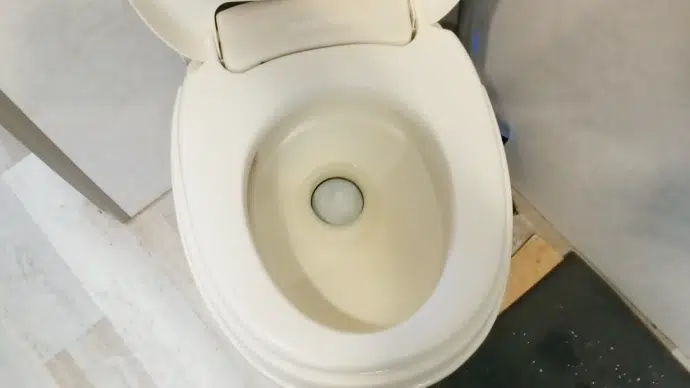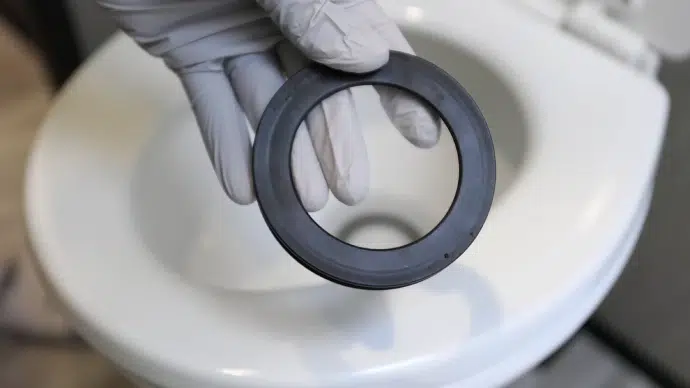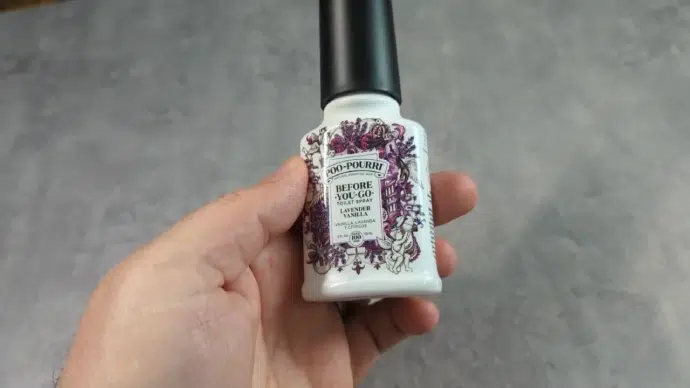Last Updated on April 20, 2023
It is essential to identify the reasons for an RV toilet filling up with water to prevent these issues from occurring in the future. Issues with the flapper valve, clogged toilet trap or drain line, and faulty water supply systems are some of the leading causes of an overflowing RV toilet.
By utilizing the troubleshooting tips mentioned above, as well as taking preventive measures such as regularly cleaning your toilet bowl and tank and using only the appropriate amount of toilet paper, you can avoid further issues from arising.
With this guide, rest easy knowing how to fix any issue while camping, giving peace of mind for whatever adventure lies ahead.
Why Does My RV Toilet Keep Filling Up with Water: Common Reasons
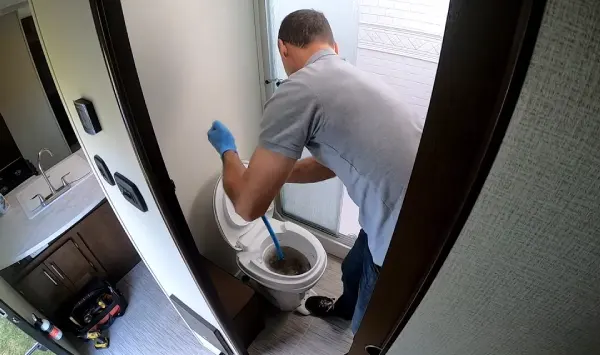
RV toilets are a convenient and essential feature for anyone who enjoys the freedom of traveling on the road. However, it can be frustrating when your RV toilet fills up with water. There are several common reasons why this may happen.
1. Issue with the Flapper Valve
The RV toilet’s flapper valve is an essential component that regulates water flow from the tank to the bowl. If this valve has an issue, water may continuously fill the toilet.
One common problem with the flapper valve is that it may become worn out or damaged over time. This can happen due to regular usage or exposure to harsh chemicals used for cleaning the toilet. The valve may not seal properly when this happens, allowing water to leak into the bowl.
Another issue is that flapper valves may get stuck in an open position. This can happen if debris or mineral buildup is in the valve assembly, preventing it from closing completely. As a result, water will continue to flow into the bowl even when it’s not needed.
2. Clogged Toilet Trap or Drain Line
A clogged toilet trap or drain line is another common reason why an RV toilet may keep filling up with water. This occurs when there is a blockage in the pipe that leads from the toilet bowl to the holding tank.
Too much toilet paper is commonly the root of plumbing woes, but other feminine hygiene products like tampons, sanitary napkins (pads), and menstrual cups are also to blame. Flushing things such as wipes or paper towels also contributes to plumbing problems. Over time, these items can accumulate and form a blockage in the drain line.
3. Faulty Water Supply System
A faulty water supply system can be one of the reasons why your RV toilet keeps filling up with water. A few components in the water supply system can cause this issue, such as the fill valve, the flapper valve, and the water pressure regulator.
- The fill valve fills the toilet tank with water after each flush. If it’s not functioning correctly, it may continue to let water flow into the tank even after it’s complete. This can cause an overflow and result in your toilet constantly filling up with water.
- Another component that can cause issues is the flapper valve. Water may flow continuously into the toilet bowl if it’s not sealing tightly or worn out. This will cause your RV toilet to keep filling up with water even when you’re not using it.
- Lastly, a faulty water pressure regulator can also be a culprit. If the regulator isn’t working correctly, it may cause too much pressure in the water supply system. This excess pressure can lead to an overfilling of your RV toilet tank.
Troubleshooting Tips for RV Toilet Filling Up with Water
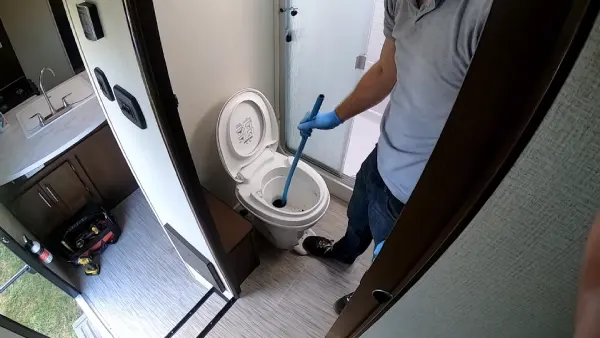
To troubleshoot an RV toilet that keeps filling up with water, there are a few steps you can take to identify and fix the issue. Here are some tips to help you get started:
Check and Clean the Flapper Valve
The flapper valve is a crucial component of the RV toilet that controls water flow from the tank into the bowl. When this valve malfunctions, it can cause the toilet to fill up with water constantly.
One common issue flapper valves face is that they become warped or damaged over time due to wear and tear. This can prevent it from sealing correctly, causing water to leak continuously into the bowl.
Another problem could be that debris and mineral buildup on the flapper valve can also cause it not to seal correctly.
To check and clean the flapper valve, turn off the water supply to your RV’s toilet and flush out any remaining water in the tank.
You can then remove the lid of your toilet tank and inspect the flapper valve for any visible signs of damage or deterioration. If you notice any issues, you may need to replace them entirely.
Cleaning your flapper valve is also essential in maintaining its functionality. You can do this by using a soft-bristled brush or a cloth soaked in a vinegar solution to scrub away any mineral buildup or debris that has accumulated on it.
Inspect and Clear the Toilet Trap and Drain Line
The toilet trap and drain line are essential to your RV’s plumbing system. They are responsible for disposing of waste and preventing any blockages that may cause your RV toilet to fill up with water.
However, if these components become clogged or blocked, they can lead to your RV toilet filling up with water.
To inspect and clean the toilet trap and drain line, you will need to follow a few simple steps. First, turn off the water supply to the toilet. This will prevent additional water from entering the system while you work on it. Then, remove the toilet bowl from the floor by unscrewing the bolts.
Once you have removed the bowl, locate the trap and drain line underneath it. You may need a flashlight or mirror to view these components competently. Check for any visible signs of blockage, such as debris or buildup.
You can clear any blockages with a plunger or snake if you notice any blockages. A plunger can create suction and dislodge clogs in the trap or drain line. A snake is a long, flexible tool that can be inserted into the pipe to break up any stubborn blockages.
After clearing blockages, reassemble your RV’s plumbing system by replacing the bowl and turning on the water supply. Test your toilet by flushing it several times to ensure everything works correctly.
Test and Repair the Water Supply System Components
The water supply system is an essential component of your RV’s toilet. If it fails, it can cause water to leak into the toilet. You can do a few things to repair and test the water supply system.
First, check the water pressure. Low pressure can result in the toilet filling slowly or not at all. On the other hand, high pressure can cause the tank to overflow. You can use a pressure gauge to measure and adjust the water pressure accordingly.
Next, inspect the water inlet valve. This valve controls the flow of water into the tank. If it is faulty, it may not allow enough water into the tank or may allow too much water in, causing an overflow.
You can test this valve by turning off the water supply and removing it from the tank. Check for any debris blocking it and replace it if necessary.
Another component to inspect is the fill tube. This tube connects the inlet valve to the overflow tube and helps regulate how much water enters your RV’s toilet bowl. A damaged or misaligned fill tube can cause an overflow or slow filling of your toilet bowl.
Lastly, check for leaks in your RV’s plumbing system that may affect your toilet’s performance. A leak in a pipe leading to your RV’s toilet could reduce or increase water flow into your toilet bowl.
Which Way Turns Off the RV Toilet Water Valve?
Shutting off the toilet water valve in your RV, generally requires a clockwise rotation. It means that you will need to turn the valve handle in a circular motion to the right.
Depending on the specific model of the RV toilet and valve, you may either have an individual valve for water flow or a lever that blocks both the water supply and drainage.
When turning off a water supply valve, it is essential to double-check with your RV’s manual or manufacturer guide. They may have specific directions for shutting off the water source. Also, after closing Rv toilet water valves, ensure all water has been drained from your toilet pan.
Preventive Measures to Avoid RV Toilet from Filling Up with Water
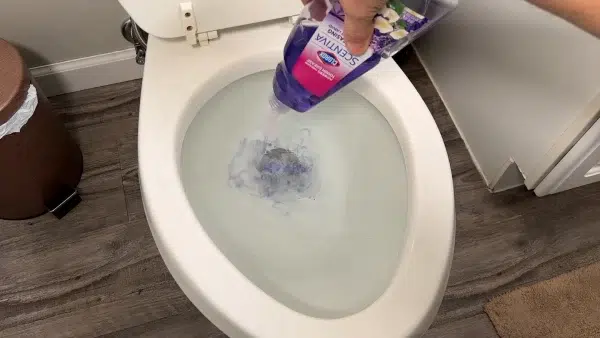
To avoid your RV toilet from filling up with water, there are some preventive measures that you can take. These measures will keep your toilet functioning correctly and save you from the hassle of dealing with a clogged or overflowing toilet.
Regularly Clean the Toilet Bowl and Tank
Cleaning the toilet bowl and tank regularly is essential to keep the RV toilet from overflowing with water. Over time, mineral deposits, bacteria, and other debris can accumulate in the toilet bowl and tank, leading to clogs and other issues.
You can use a specialized toilet bowl cleaner such as Pine Sol or a mixture of baking soda and vinegar to clean the toilet bowl. Apply the cleaner or mixture to the inside of the bowl and scrub with a brush. Be sure to clean under the rim of the bowl as well.
To clean the tank, you must first drain all the water. You can do this by turning off the water supply to your RV and flushing the toilet until all the water is gone. Once drained, you can use a solution of bleach and water (1/4 cup bleach per gallon of water) or an RV-specific tank cleaner to scrub down the interior walls of the tank.
After cleaning the bowl and tank, rinse thoroughly with clean water before using it again.
Regular cleaning helps prevent clogs and maintain the proper functioning of your RV toilet system. Keeping your toilet clean reduces wear and tear on components such as valves and seals that can lead to leaks or other issues over time.
Use an Appropriate Amount of Toilet Paper
Using appropriate toilet paper is crucial for preventing water from filling up your RV toilet. Excessive use of toilet paper can cause blockages in the drain line, leading to a backup of water in the bowl. This can be a frustrating issue and may require professional assistance.
Using only the necessary toilet paper is essential to avoid this problem. It’s recommended to use single-ply RV-specific toilet paper that dissolves easily in water. Avoid using regular household toilet paper as it doesn’t break down as quickly and can cause clogs.
Another way to reduce the risk of your RV toilet filling up with water is using a bidet or wet wipes for personal hygiene. This reduces the amount of toilet paper used and helps keep the bowl clean and debris-free.
It’s important to note that flushing anything other than human waste and RV-specific toilet paper down the toilet can also cause blockages and backups. Avoid flushing feminine hygiene products, baby wipes, or any other non-biodegradable items down the drain.
Be Mindful of What You Flush Down the Toilet
One of the most important things to remember when preventing your RV toilet from filling up with water is to be careful with what you flush.
Unlike regular household toilets, RV toilets have a limited capacity and are not connected to a municipal sewer system. This means that anything you flush down the toilet goes directly into the holding tank, and if too much waste or debris accumulates, it can cause clogs and backups.
To prevent this from happening, it’s essential only to flush human waste and toilet paper down the toilet. Avoid flushing anything else, such as feminine hygiene products, baby wipes, paper towels, or food scraps. These items can quickly fill up your holding tank and cause problems with your RV’s plumbing system.
In addition to being aware of the contents of your RV toilet, there are other preventive measures to prevent your RV toilet from filling up with water.
Regularly cleaning the toilet bowl and tank can help prevent buildup and keep everything running smoothly. Appropriate toilet paper is also essential; too much can quickly fill the holding tank.
Reasons Why You Should Turn Off the RV Toilet Water
Stopping the RV toilet water helps prevent wastewater from backing up and overflowing and avoids RV floor damage due to leakage. Following are some reasons you should turn off your RV’s toilet water:
Prevent Backup and Overflow
One of the primary reasons it’s essential to turn off your RV toilet water is to prevent wastewater from backing up or overflowing. When you turn off the water supply, you reduce the chance that any wastewater will escape your system.
This can be especially helpful if you’ve recently used a large amount of water in your bathroom or kitchen area since this could put too much pressure on pipes and tanks. Also, turning off the toilet water helps to ensure that any sewage won’t be able to back up into areas where it shouldn’t go.
Prevent RV Floor Damage
Another reason RV toilet water should be turned off is that it can protect the floor of your recreational vehicle. Excess pressure on the plumbing system due to too much wastewater present at one time can cause floors in your RV to buckle or even have standing puddles form on them if they become too saturated with moisture.
Prevent Pipe Leaks
Disconnecting the RV toilet water prevents pipe leaks in your RV. This is because the water pressure inside the pipes can build up, resulting in a significant amount of strain on them and eventually causing them to leak or burst.
To avoid this, the owner must turn off incoming water from the toilet by turning off the main line that supplies water directly from your fresh water tank or external water source. Doing this will ensure that all pressure is removed from your pipes, and you can rest assured that leaks will not occur.
Prevent Pipes From Freezing and Bursting
If you’re traveling in colder climates during the winter, it’s crucial to shut off the RV toilet water, as freezing temperatures can cause significant damage to any water-exposed pipes within your RV.
You can turn off the main valve supplying water from your water tank or other external water sources so that you can minimize any risk of freezing. If the pipes freeze solid, there will be no pressurized flow, which could cause them to crack or burst.
Conserve Water During Boondocking
When boondocking for extended periods, one of the main focuses should be conserving as much fresh drinking water as possible, which requires some level of awareness and preparation beforehand, including turning off your RV toilet water supply before hitting the road.
Doing so ensures that no additional sources are draining out from beneath your vehicle while on the go, which means fewer trips back into town for refills and more peace of mind knowing that your resources won’t suddenly run out, leaving you stranded with nowhere else to go.
Where does water come from to flush RV toilets?
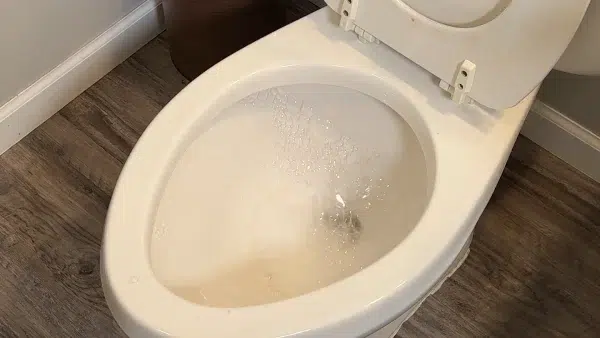
Water for flushing an RV toilet can come from either the RV’s freshwater tank or a campsite water hook-up. This water is necessary to keep the bowl of the toilet full and ensure proper odor control, as well as keep the seal from drying out.
The flushing process can be done through a foot pump or electric flush system, depending on the type of toilet installed in the RV.
Do All RV Toilets Have a Water Shut-Off Valve for Turning Off Water?
All RV toilets should include a water shut-off valve to turn off the water. These RV toilets’ water shutoff valve is necessary because it prevents water from stagnating and becoming a breeding ground for bacteria. These valves are usually located either on the back of the unit or underneath.
This shut-off valve allows you to turn the water off to the toilet without turning it off to the entire RV. It is an excellent feature if you need RV toilet repair or if you are leaving your RV for an extended period. Also, some models have an indicator light illuminating when the valve is closed.
With a shutoff valve, you can simply turn off the water supply and rest assured that no leakage will occur. Having a shut-off valve helps conserve water by only supplying what is needed.
Can You Flush an RV Toilet with the Water Valve Off?
If there is insufficient water in the pipe, you may be unable to flush an RV toilet when the water valve is off. This is because the water in the toilet bowl needs to be replaced by fresh, clean water to flush properly.
An RV toilet is designed to work only when there is enough water pressure and a tank of fresh, clean water. Without this, it would be impossible for the waste to be flushed out properly, as the pressure needed is unavailable.
Is it Safe to Leave a Water-Turned-Off in RV Toilet for an Extended Period?
It is generally not recommended to keep a water-turned-off in an RV toilet for a prolonged period if there is still water in the tank. This is because, over time, standing water can build up in the pipes and storage tank, potentially leading to various problems such as corrosion, debris buildup, and leaks.
Corrosion can also occur if the stored water has high amounts of minerals which interact with other elements in the system and cause them to degrade. Debris buildup occurs when stagnant water is inside the piping and tank system. This can lead to clogs or leaks that can be hard to repair without professional help.
Is it Safe to Shut Off the RV’s Main Water Supply When You Turn Off the RV Toilet Water?
It is not recommended to shut off the main water supply of your RV before turning off the water for the toilet. While this may seem like a good idea, it can cause permanent damage to the plumbing and wastewater systems in your RV. Sometimes, it can even void the manufacturer’s warranty on your vehicle.
When you switch off the primary water source of your RV, it will also cut off all other water sources, such as sinks and showers. This can result in inadequate pressure or no water flow throughout your RV if you turn on one faucet or shower head at a time. Fluctuations in pressure inside the pipes could cause severe damage to pipes and valves.
Another potential problem with shutting off the main water supply before turning off the toilet is that it could cause an overflow in the toilet tank if there is still water left in it when you turn it back on again. This could create an unsanitary mess that would need immediate remediation or repair work from a professional plumber.
Also, any existing waste material accumulated in the tank may spill out into other areas of your RV, causing further contamination and health risks for you and any passengers who might be present.
Why is RV Toilet Still Running With the Water Valve off?
There could be several reasons your RV toilet is running even though the water valve is off. The first thing you should check is if the water flush valve has been completely shut off. If it hasn’t, this is likely the cause of the running water. To stop it, you must ensure that the valve is securely closed.
The next thing you should look into is whether or not the fill tube connected to your RV toilet is clogged. If this tube is blocked with debris, it will restrict the water flow and cause your toilet to keep running even when the valve has been turned off. You can use a plunger or snake to clear blockages from this tube.
In some cases, malfunctioning float or flush valves may also be responsible for why your RV toilet continues to run after turning off its valve. Before inspecting these parts, you must turn off the main water supply and disconnect all power sources from the area to avoid electric shock hazards.
Should You Keep Turn Off the RV Toilet Water When Storing it?
Yes, it is recommended that you keep the toilet water turned off when storing your recreational vehicle (RV). This will ensure that the system is not damaged due to frozen or clogged lines. Also, it can help prevent any unexpected leaks or damage from occurring while the RV is in storage.
By turning off the water shut-off valve, you can also help save on your utility bills since water will not run through the pipes when not in use. Also, this will help reduce the risk of corrosion and other damage from stagnant water sitting in the pipes for extended periods.
When preparing to store your RV for an extended time, turn off all valves related to the toilet and all other water sources within your RV. Plus, you should always run a small amount of diluted burst protection RV antifreeze through each pipe to ensure they do not freeze over during cold winter months.
What are the most common RV toilet leaks?
The most common RV toilet leak is a floor leak. Floor leaks occur when water seeps out of the base of the toilet after flushing, typically caused by a deteriorated gasket or seal due to movement and flexing.
Other factors that can lead to leakage include cracked toilet bowls, worn-out gaskets, faulty water supply lines, loose connections, or damaged connectors.
How can I stop my RV toilet from flooding?
To prevent your RV toilet from flooding, you should first drain any remaining water from your toilet bowl. Then turn off the water shut-off valve for your RV toilet and identify what is causing the flooding (e.g. high water pressure or a clog). You may need to purchase a water pressure regulator or use a plunger if needed.
If necessary, purchase replacement parts as recommended by the manufacturer’s instructions and consult a professional. Finally, turn your water back on and check for any new signs of leaking before using it again.
Enjoy Camping Without Toilet Troubles
A continuously filling RV toilet can be frustrating and unpleasant. However, with a proper understanding of the common reasons behind this issue and implementing the troubleshooting tips mentioned above, you can easily solve this problem.
Remember to regularly clean your toilet bowl and tank, use appropriate toilet paper, and wash your hands after using the bathroom.
Don’t let a dirty RV toilet ruin your next trip by remembering these tips. With this knowledge, you can enjoy camping without any plumbing issues.
